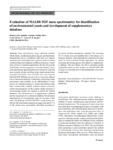Por favor, use este identificador para citar o enlazar este ítem:
http://www.alice.cnptia.embrapa.br/alice/handle/doc/997892Registro completo de metadatos
| Campo DC | Valor | Lengua/Idioma |
|---|---|---|
| dc.contributor.author | AGUSTINI, B. C. | pt_BR |
| dc.contributor.author | SILVA, L. P. da | pt_BR |
| dc.contributor.author | BLOCH JUNIOR, C. | pt_BR |
| dc.contributor.author | BONFIM, T. M. B. | pt_BR |
| dc.contributor.author | SILVA, G. A. da | pt_BR |
| dc.date.accessioned | 2016-02-22T12:39:32Z | - |
| dc.date.available | 2016-02-22T12:39:32Z | - |
| dc.date.created | 2014-10-21 | pt_BR |
| dc.date.issued | 2014 | pt_BR |
| dc.identifier.citation | Applied Microbiology and Biotechnology, v. 98, n. 12, p. 5645-5654, 2014. | pt_BR |
| dc.identifier.uri | http://www.alice.cnptia.embrapa.br/alice/handle/doc/997892 | pt_BR |
| dc.description | Yeast identification using traditional methods which employ morphological, physiological, and biochemical characteristics can be considered a hard task as it requires experienced microbiologists and a rigorous control in culture conditions that could implicate in different outcomes. Considering clinical or industrial applications, the fast and accurate identification of microorganisms is a crescent demand. Hence, molecular biology approaches has been extensively used and, more recently, protein profiling using matrix-assisted laser desorption/ionization time-of-flight mass spectrometry (MALDI-TOF MS) has proved to be an even more efficient tool for taxonomic purposes. Nonetheless, concerning tomass spectrometry, data available for the differentiation of yeast species for industrial purpose is limited and reference databases commercially available comprise almost exclusively clinical microorganisms. In this context, studies focusing on environmental isolates are required to extend the existing databases. The development of a supplementary database and the assessment of a commercial database for taxonomic identifications of environmental yeast are the aims of this study. We challenge MALDI-TOF MS to create protein profiles for 845 yeast strains isolated fromgrape must and 67.7% of the strains were successfully identified according to previously available manufacturer database. The remaining 32.3 % strains were not identified due to the absence of a reference spectrum. After matching the correct taxon for these strains by using molecular biology approaches, the spectra concerning the missing species were added in a supplementary database. This new library was able to accurately predict unidentified species at first instance by MALDI-TOF MS, proving it is a powerful tool for the identification of environmental yeasts. | pt_BR |
| dc.language.iso | por | pt_BR |
| dc.rights | openAccess | pt_BR |
| dc.subject | Levedura | pt_BR |
| dc.subject | MALDI-TOF MS | pt_BR |
| dc.title | Evaluation of MALDI-TOF mass spectrometry for identification of environmental yeasts and development of supplementary database. | pt_BR |
| dc.type | Artigo de periódico | pt_BR |
| dc.date.updated | 2019-04-02T11:11:11Z | pt_BR |
| dc.subject.thesagro | Microrganismo | pt_BR |
| dc.subject.thesagro | Levedo | pt_BR |
| dc.subject.thesagro | Biologia molecular | pt_BR |
| dc.subject.thesagro | Base de dados | pt_BR |
| dc.subject.thesagro | Genética | pt_BR |
| dc.subject.nalthesaurus | Yeasts | pt_BR |
| dc.subject.nalthesaurus | Molecular biology | pt_BR |
| dc.description.notes | DOI: 10.1007/s00253-014-5686-7 | pt_BR |
| riaa.ainfo.id | 997892 | pt_BR |
| riaa.ainfo.lastupdate | 2019-04-02 -03:00:00 | pt_BR |
| dc.contributor.institution | BRUNA CARLA AGUSTINI, CNPUV; LUCIANO PAULINO DA SILVA, CENARGEN; CARLOS BLOCH JUNIOR, CENARGEN; GILDO ALMEIDA DA SILVA, CNPUV. | pt_BR |
| Aparece en las colecciones: | Artigo em periódico indexado (CNPUV)  | |
Ficheros en este ítem:
| Fichero | Descripción | Tamaño | Formato | |
|---|---|---|---|---|
| SilvaAMB.pdf | 279.34 kB | Adobe PDF |  Visualizar/Abrir |









